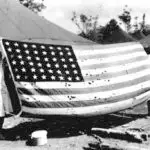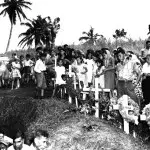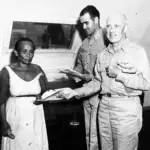Impact of Japanese Military Occupation of Guam



Table of Contents
Share This
Political, economic and social impacts
The Japanese military occupation of Guam, from December 1941 through July 1944, resulted in a variety of political, economic and social impacts on the people of Guam that emerged for the most part during the post-war period.
The most remarkable political impact was a change in CHamoru/Chamorros’ perception of the United States. Although the Chamorros had not always been receptive to the pre-war US Naval Administration, particularly due to discriminatory treatment, they generally held pro-American sentiments as they repeatedly attempted to obtain US citizenship. Their harsh wartime experiences with Japan, however, made their feelings more pro-American and strengthened their political dependency on the US.
Because Japan occupied Guam during World War II, Chamorros now more clearly recognized Guam’s place in the international arena, specifically that the island is an important strategic location in the Western Pacific close to Japan, the US’s former enemy. Chamorros also came to understand the ambiguity of political status in the Micronesian islands (Japan’s former mandated territory surrounding Guam and, since 1947, a United Nations trusteeship) making Guam’s status as part of the US additionally important.
Recognizing these factors, the majority of Chamorros, both mentally and physically, have consistently supported a US presence on the island from 1944 to the present.
Pre-war Guam economy, though on a small scale, was semi-self-sufficient, exporting only copra. The economic damages caused by the Japanese occupation were, enormous. These included:
- a seizure of assets,
- an unreasonable low exchange rate of US dollars to Japanese yen,
- the exploitation of labor for land development plans and fortifications,
- shortage of food and life’s necessities and
- the destruction of homes.
Japan’s policy for nationalization of occupied lands, coupled with the US military landing, militarization and demolition of land during a fight to the death at the American retaking of Guam, caused great confusion as to land ownership and alienation of land soon after the US recaptured Guam. Much of the Chamorros’ agriculture and other lands that had been taken by the Japanese military during the occupation were re-defined as US military farms under the US Commercial Company (USCC) of the federal government. By 1947, these became the responsibility of the island Department of Agriculture.
The US Navy planned to obtain up to 75,700 acres out of nearly 140,000 total acres in 1945 through purchase, or condemnation (by writ of eminent domain), or lease from Chamorros to develop Guam into a substantial military base, second to only Pearl Harbor in the Pacific. The US was anticipating potential conflict with Communist China or the Soviet Union, or with both. This was in addition to 28,000 acres already owned by the US since the pre-war period, which had previously been Spanish crown lands surrendered to the US as a consequence of the Spanish-American War. The acquisition of land became possible during total post-war military rule and rehabilitation of Guam by means of US assistance.
As a result of Japanese military coercion and numerous atrocities against the Chamorro people, the Chamorros’ strong anti-Japanese views remained in post-war Guam, at least until the late 1960s when Japanese hotel investors began to be welcomed. Because the high-ranking Japanese military personnel who held rule over Chamorros were killed during the desperate fighting in 1944, civilian hostility was targeted at the Japanese residents who had immigrated to Guam in pre-war years. A few of these people collaborated with the Japanese military and were tried by the US Navy war crimes court. The Japan Club president, for example, who had been residing on Guam for forty years, was sentenced to death (later commuted to fifteen years imprisonment). Other Japanese residents who also had immigrated to Guam in the early 1900s were expelled to Saipan or Japan. More than 200 people with Japanese fathers and Chamorro mothers had to face in strong anti-Japanese sentiment in the post-war island community.
The Chamorros on Guam also directed their indignation toward the Chamorros from the Northern Marianas. Several Northern Mariana Chamorros had worked for the Minseibu (Japanese Navy Civil Administration Department) as interpreters and patrolmen and were seen by Guam Chamorros as “collaborators” of the enemy. In truth, however, the Northern Mariana Chamorros had been raised under the Japanese regime which had taken over those islands in 1914 from Germany and were a part of the Japanese military contingent.
Chamorros were torn by the situation as shown by the decision the islanders made regarding their future political status in a plebiscite held in the Northern Mariana islands on 5 February 1961. Northern Mariana voters favored political reintegration with Guam by sixty-five percent, though another thirty-four percent chose a separate territorial status for the Northern Mariana islands.
Eight years later, in a Guam plebiscite held 4 November 1969, fifty-eight percent of Guam voters said they were against reintegration with the Northern Marianas, though forty-two percent voted in favor of it. Part of the reason for the Guam results, however, were also due to the mistaken belief by Guam’s leaders that Guam would carry the burden of improvements to the Northern Marianas infrastructure if the islands were re-unified.
The psychological impact of war on Guam residents still remains in the form of unpaid war reparation claims. The Allied Powers waived all reparation claims arising out of any wartime actions taken by Japan based on the Treaty of Peace with Japan (1951) signed between Japan and forty-five countries including the US. Because of this agreement, Guam is instead seeking reparations from the US.
War Claims were paid to the residents of Micronesia as they were considered to be a part of the Japanese Empire during the War.
As of June 2006 the House Judiciary Committee, US Congress, voted to approve $180 million in payments as war reparations to the Chamorro people from the US government. To date, there has been no further action on this bill.
For further reading
Higuchi, Wakako. “Japan and War Reparations in Micronesia.” Journal of Pacific History 30, no. 1 (June 1995): 87-98.
––– Remembering the War Years on Guam: A Japanese Perspective. Submitted to the War in the Pacific National Historical Park, National Park Service, Guam. Mangilao: University of Guam, 2001.
––– “A U.S. Territory in Japan’s South Sea Islands: The Japanese Navy Administration of Guam.” PhD diss., Australian National University, 2006.
Leibowitz, Arnold H. Defining Status: A Comprehensive Analysis of United States Territorial Relation. Leiden: Martinus Nijhoff, 1989.
Rogers, Robert. Destiny’s Landfall: A History of Guam. Honolulu: University of Hawai’i Press, 1995.
